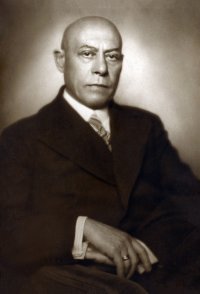Rudolf Tintner - The Master Builder and Chronicler of Theresienstadt
It was a cold day, snow was falling, when 84 people boarded a wagon guarded by four „Schutzpolizisten” at Vienna's North Station on 10 March 1944, bound for Theresienstadt. One of them was the former city builder of St. Pölten Rudolf Tintner. The architect, who came from an assimilated upper middle-class family, was born in Brno on 7 June 1878. In 1907 he opened a construction company in St. Pölten and shaped the appearance of the city both with large projects, such as the Glanzstoff-factory, and with several dignified residential buildings.
Immediately after the November pogrom, Rudolf Tintner, who had already converted to Catholicism before the First World War, had to leave St. Pölten, close his companies and watch his property being „Aryanised”.
Still on the train, Tintner wrote the first – pre-printed – postcard to his daughters in Vienna and started a diary a few days later. Shortly after his arrival in Theresienstadt, he found employment in the camp's construction department. Due to his professional experience, he subsequently took over the management of the department and received a major „Potemkin order”: on the occasion of a propagandistically prepared „visit” by a commission of the International Red Cross, the SS had ordered a „beautification campaign” of Theresienstadt. Rudolf Tintner and the staff of the building department now had to design facades, build a café, a children's pavilion and a sports field, rebuild the theatre and, above all, hide the misery of the camp. Tintner recorded everything.
On 9 January 1945, after ten months of imprisonment and four months before the liberation of Theresienstadt by the Red Army, Rudolf Tintner's records came to an abrupt end. The following night he died in his office at Langestraße 9. On 13 January he was cremated in Theresienstadt, the urn was brought to Vienna by a fellow prisoner after the liberation and buried at the Vienna Central Cemetery. It is the only urn from Theresienstadt that was buried in Austria.
What has survived is a diary with 274 entries describing 251 singular events, naming 125 people and listing 54 places. The compendium also consists of four letters, a postcard and seven poems. The uniqueness of the source material lies in the existence of three different Ego documents of a person that were created at the same time. Whereas with other sources one can only speculate which information was considered unimportant and therefore not reported, in Rudolf Tintner's compendium it is clearly visible that, depending on the purpose of the respective document, information was specifically described or omitted altogether.
The aim of the project is a monograph that will be published in the series of the Institute for Jewish History in Austria by Studien Verlag. The publication will contain Rudolf Tintner's diary, letters, postcards and poems and will also provide a historical classification with critical comments. In addition, all the people, places and events mentioned will be classified or located.
Information: |mail: Benjamin Grilj|
